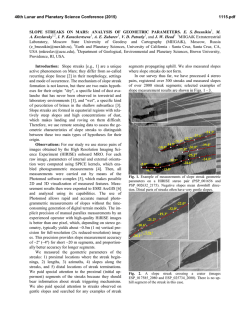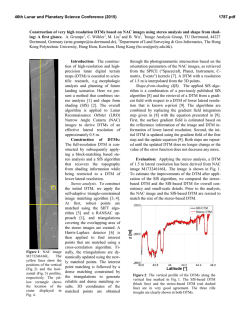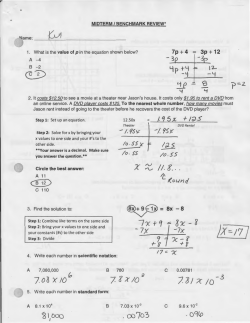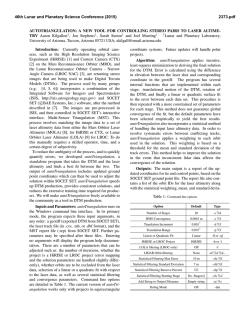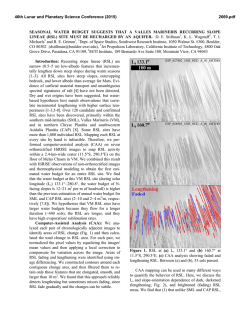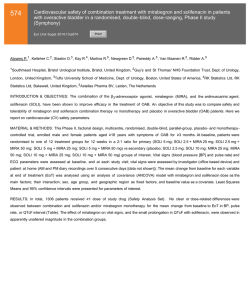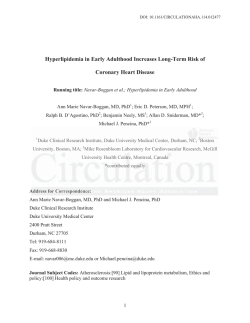
Frequency Distributions of Topographic Slopes on the Moon
46th Lunar and Planetary Science Conference (2015) 2848.pdf FREQUENCY DISTRIBUTIONS OF TOPOGRAPHIC SLOPES ON THE MOON. M. A. Kreslavsky1,2, A. Yu. Bystrov2, I. P. Karachevtseva 1Earth and Planetary Sciences, University of California - Santa Cruz, Santa Cruz, CA, USA, [email protected], 2MExLab, Moscow State University of Geodesy and Cartography (MIIGAiK), Moscow, Russia. Introduction: Statistical characterization of topographic slopes is a valuable tool for comparison of planetary landscapes and understanding of landscape evolution processes. It also gives essential engineering information need for exploration activity. Here we follow up earlier LOLA-based studies [1] with addition of short-baseline slope data from the digital terrain models (DTM) derived from LROC NAC stereo images [2]. We also briefly list relevant theoretical background, which has not been properly presented in the planetary science literature. Theoretical background: The usual quantity of interest, "slope" s, also dubbed as "2D slope" is defined as the absolute value of gradient vector of surface elevation calculated at certain baseline. On the other hand, it is often much easier and more accurate to measure not the gradients, but slopes p along linear profiles across the surface, also dubbed "1D slopes". The relationship between statistical properties of 1D and 2D slopes [e.g., 3] can be established in the frame of a theoretical stochastic model that considers the topographic gradient as an isotropic random vector. The isotropy assumption is often reasonable for the Moon and other bodies with landscapes dominated by impacts, but it fails for many terrestrial, martian, etc. landscapes. Under the isotropic assumption, the probability density functions f1D(p) and f2D(s) of 1D and 2D slopes are related to each other through the following modification of the Abel transform: 1 ∞ f 2 D ( s )ds ; (1) f 1D ( p) = π | p| s 2 − p 2 ∫ f 2 D ( s ) = −2 d ds ∫ ∞ s f1D ( p) pdp p2 − s2 . (2) This transform can be numerically applied to empirical frequency distributions as proxies for the probability densities. The (cumulative) distribution function F2D(s), the probability that the absolute value of the gradient is above s, ∞ ∞ f ( p ) pdp 1D . (3) F2 D ( s ) = f 2 D ( s ' )ds ' = 2 s s p2 − s2 ∫ ∫ is a proxy for the proportion of area tiled steeper than s. The singularity under integrals in (1) - (3) requires special numerical integration algorithms. Note that "slopes" p and s above are the tangents of slope angles. The probability density function fa(θ) of slope angle θ in degrees is related to the probability density f of tanθ as the following: f a (θ) = π 180 f (tan θ) cos 2 θ ; ( 2 (4) ) f (t ) = 180 π f a (arctan t ) 1 + t . (5) Data processing. For this study we selected several LROC NAC DTM products [2] to study shortbaseline slopes and larger test areas surrounding each DTM to study longer-baselines slopes with LOLA data. We selected only those DTM that represented typical geologically homogeneous terrain away from large young craters, prominent linear topographic features, etc. We also excluded DTM with gaps due to shadows in the original stereo images. For each selected DTM we also chose a circular geologically homogeneous area containing the DTM (not necessarily in its center). We chose the circle diameter of 150 km, except Apollo-14 landing site, where we used diameter of 90 km to place the whole test area within the contiguous patch of Fra Mauro Formation. Slopes from LOLA data. We used individual LOLA profiles from the circular LRO orbit. We calculated 1D slopes between consecutive laser shots, which gave the baseline of 57.5 m, as well as slopes at 4×, 16×, and 64× longer baselines (230 m, 920 m, and 3.7 km). Typically we obtained ~6×105 slopes for each sample site and each baseline. Each LOLA laser shot was split into 5 spots giving 5 elevation measurements [4]. We also calculate slopes between spots 1-2, 1-3, 1-4, and 1-5 and thus obtained 1D slopes at 25 m baseline, ~106 slopes for each sample site. We generated slope histograms with 0.1º increment in slopes and thus obtained slope-frequency distributions; examples are shown in Fig. 1. Using (3) we calculated distributions of 2D slopes and derived the median slopes (Fig. 2). Slopes from LROC NAC DTM. The DTM pixels are 2 m in size. Statistics of slopes the shortest possible, 2 m baseline is significantly distorted by peculiarities of the interpolation algorithm used in the process of DTM generation. To mitigate this problem we smoothed the DTM using ArcGIS tools, namely "5x5 blur" repeated 4 times. Our analysis showed that this smoothing procedure is equivalent to Gaussian low-pass filter with the half-width of σ = 2.13 pixels. Then we calculated 2D slopes at each pixel. The effective baseline of these slopes is defined by the smoothing procedure; we consider 2σ (8.5 m) as a proxy to it. We generated slope histograms with 0.5º increment in slopes and thus obtained incremental slope-frequency distributions. For many sample sites, the median 2D slopes at 8.5 m baseline turned out to be somewhat lower than ex- 46th Lunar and Planetary Science Conference (2015) is proportional to exp(-p/tanθh), where parameter θh = 6.0º is the same for all highland samples. Thus, km-scale topography of the highlands have a universal slope parameter of ~6º; its physical nature is unclear. 10 Luna 20 5 Median slope, deg pected from extrapolation of longer-baseline LOLA data (see "Luna 16" site in Fig. 2). This is probably caused by the difference in the slope measurement technique. Individual LOLA laser spots (~5 m size) are much smaller than the baseline, which causes leakage of high-spatial-frequency topographic signal, while for the smoothed DTM the effective spot size is equal to the effective baseline, and no such leakage occurs. We used (1) to recalculate 2D slope distributions into 1D slope distributions, and compared them with 25 m baseline results from LOLA (Fig. 1). We saw good agreement in the distribution shapes. 2848.pdf 3 Apollo 14 2 1 Luna 16 Baseline: 25 m Frequency 0.5 10 Luna 20 100 1000 Baseline, m Luna 16 0 10 Fig. 2. Scale dependence of the median slope for typical highlands (Luna 20), typical maria (Luna 16), and Fra Mauro Formation (A14). A14 20 1D slope, deg 30 Fig. 1. Incremental frequency distribution of 1D slopes at 25 m baseline for typical highlands (Luna 20), typical maria (Luna 16), and Fra Mauro Formation (A14). Note log scale on the vertical frequency axis. Results: The slope-frequency distributions on the Moon have a rich structure (Fig. 1). All distributions have significant steep-slope tails. They show distinctive rollover starting at ~25º 1D slopes; there are virtually no slopes steeper than ~36º. This rollover is apparently related to the angle of repose. There are no processes on the Moon that could effectively produce short slopes steeper than the angle of repose (on the Earth water erosion is doing that). Highlands. For each of our typical highland samples, the slope distributions are almost the same for different baselines, excluding the longest one; consequently, the median slopes do not change with scale. This is consistent with the Hurst exponent of ~1 reported for highlands in [1]. This means that all shortbaseline slopes are actually inherited from larger, kilometer-scale topographic forms. Contribution of smaller objects into slope distribution is negligible. Different highland samples have somewhat different median slopes, however, the distributions show that the difference is due to different proportions of area with slopes below ~5º, while in a wide slope range from ~5º to ~25º the distribution in linear in the loglinear plot (Luna 20 in Fig. 1), which means that f1D(p) Maria. Our typical mare samples have remarkably similar slope distributions. They have sharp wellpronounced low-slope peak whose width defines the median slope, heavy peak shoulder that grades into the steep-slope tail. The latter is obviously related to walls of fresh craters. For longer baselines the peak with its shoulder becomes narrower, preserving its general shape and just suggesting some fractal-like topography. Apparently it is formed by equilibrium between emplacement of small craters and their obliteration by regolith gardening [5]. Other samples. At the sorter baselines, the Fra Mauro Formation (A14 in Fig. 1) is similar to highlands, but much smoother with θh = 3.7º, while at the longer baselines the distribution grades into mare-like. The vicinity of Bhabha crater in the South Pole Aitken basin in LOLA data clearly shows ~1:1 mixture of typical mare and typical highland slope distributions at all baselines, which perfectly corresponds to the geological nature of the terrain. LROC DTM does not sample maria, and the derived distribution is indeed similar to highlands, but with rather low median slope. Conclusions: Slope-frequency distributions are a rich data set worth of further more systematic analysis. References: [1] Rosenburg M. et al (2011) JGR, 116, E02001. [2] Robinson M. et al. (2010) Space Sci. Rev., 102, 293. [3] Aharonson O. and Schorghofer N. (2006) JGR, 111, E11007. [4] Smith D. et al. (2010) GRL, 37, L18204. [5] Kreslavsky M. et al.. (2013) Icarus, 226, 52. Acknowledgements: This work was carried out at MIIGAiK and supported by Russian Science Foundation, project 14-22-00197.
© Copyright 2025
